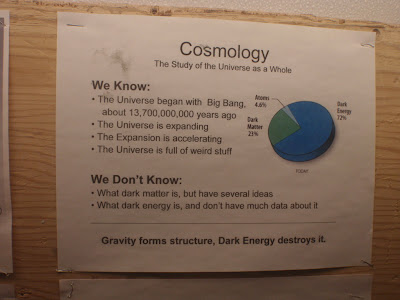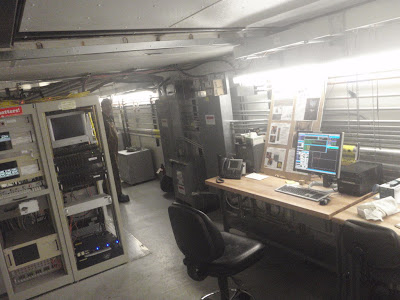The sign said -115 F with wind. Heading out to the telescope on a lovely Sunday evening isn't so bad because the wind is against the back, but returning to the station is a different story. My clothes froze to the point they were rock solid.
 Anything lower than -100 F calls for at least 5 layers.
Anything lower than -100 F calls for at least 5 layers.
 SPT and BICEP.
SPT and BICEP.
 The Cosmic Microwave Background (CMB) consists of photons at very low energy levels (T.A. = 10^-5) and is a relatively homogeneous remnant from the big bang, meaning that throughout the universe CMB temperatures are constant. Deviations from the baseline temperature indicate either excitement or downgrades in energy. Since, CMB is of a low energy it's wavelength is of the microwave spectrum, i.e., 95 GHz. If a CMB photon passes through a galaxy cluster, the most massive entities known to exist in the universe, electrons from the cluster may excite the photon and increase it's energy, thus temperature. This energy increase pushes the photon outside the selected microwave spectrum viewed by the South Pole Telescope and indicates a point source on a map of where a galaxy cluster is. In order to view the microwave spectrum of the universe SPT needs to be cooled to almost absolute zero. Some 40 scientists and engineers from various universities have successfully worked together and created a system that cools the microwave sensors down to -0.27 K using H3. At that temperature the sensors operate in a near superconducting state. Within the sensor chamber the few molecules that can exist at such low temperature are helium.
The Cosmic Microwave Background (CMB) consists of photons at very low energy levels (T.A. = 10^-5) and is a relatively homogeneous remnant from the big bang, meaning that throughout the universe CMB temperatures are constant. Deviations from the baseline temperature indicate either excitement or downgrades in energy. Since, CMB is of a low energy it's wavelength is of the microwave spectrum, i.e., 95 GHz. If a CMB photon passes through a galaxy cluster, the most massive entities known to exist in the universe, electrons from the cluster may excite the photon and increase it's energy, thus temperature. This energy increase pushes the photon outside the selected microwave spectrum viewed by the South Pole Telescope and indicates a point source on a map of where a galaxy cluster is. In order to view the microwave spectrum of the universe SPT needs to be cooled to almost absolute zero. Some 40 scientists and engineers from various universities have successfully worked together and created a system that cools the microwave sensors down to -0.27 K using H3. At that temperature the sensors operate in a near superconducting state. Within the sensor chamber the few molecules that can exist at such low temperature are helium.
What the SPT's CMB detection tells us is where galaxy clusters are and what the universe looks like. The two key theories that are predecessors to any further SPT inquiries are: (1) the universe is expanding and (2) it's expansion is of a linear fashion. The Cosmic Microwave Background is the result of the universe's expansion; energy from the big bang traveled so far that it cooled down to the very reaches of the microwave spectrum. Slow, cold moving photons. Furthermore, if these CMB photons get excited while in a galaxy cluster they transport energy elsewhere in the universe. The photons do not adhere to gravity, even if excited, they simple pass on though a cluster. This to me is a sign that yes, the universe is expanding, but it is also cooling. Think about our own solar system. For a billion or so years the sun will get more luminious and hot, but eventually it will use up all it's nuclear fuel, expand, and cool to a red giant (in ~5 billion years). Earth will be toast.
Expansion and cooling is what current physics tells us is going on. But, I beg the question, cannot dark matter outweigh dark energy and reverse the cycle and produce universal contraction? Big Bang #2? Dark energy is the energy behind the universes expansion and dark matter is very heavy material with so much gravity that it holds galaxies in place. Galactic and stellar matter is inside dark matter. If there was no dark matter than spiral galaxies and galaxies alike would just spiral away into the depths of the universe where they would cool and decay into the most basic elements of energy; photons.









 The changes in colour indicate deviations from the CMB mean baseline temperature.
The changes in colour indicate deviations from the CMB mean baseline temperature.


 Helium traverses through these cables and gets boiled to H3.
Helium traverses through these cables and gets boiled to H3.
 Here's the refridgeration unit.
Here's the refridgeration unit.

 SPT has a 20 minute battery bank. If there's a power outage they must dock it to the station and heat part of it with space heaters in order to keep some of the gadgets functioning.
SPT has a 20 minute battery bank. If there's a power outage they must dock it to the station and heat part of it with space heaters in order to keep some of the gadgets functioning.
 Power.
Power.
 Outside. 24 hours until sunset.
Outside. 24 hours until sunset.
 BICEP.
BICEP.

 The SPT command station. Keeping an eye on temperatures is the main task.
The SPT command station. Keeping an eye on temperatures is the main task.

 SPT. If scientists find a point source for a galaxy cluster they text NASA, who then go to other satellites, like Hubble, and look in that direction for a visual shot of the cluster.
SPT. If scientists find a point source for a galaxy cluster they text NASA, who then go to other satellites, like Hubble, and look in that direction for a visual shot of the cluster.
 The docking bay being opened.
The docking bay being opened.



 The brain.
The brain.
 I wonder what it's IQ is.
I wonder what it's IQ is.


 Heading back was colder than $#!*.
Heading back was colder than $#!*.
 Then we did 2 hours of fight club. We practiced trips and falls on mats.
Then we did 2 hours of fight club. We practiced trips and falls on mats.






































